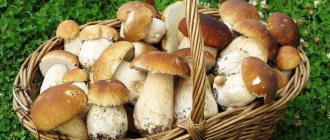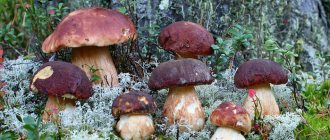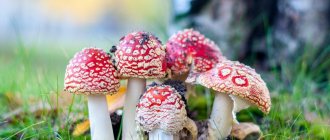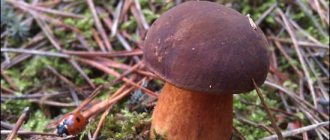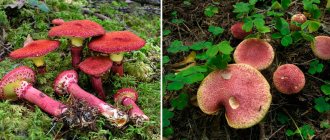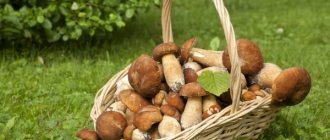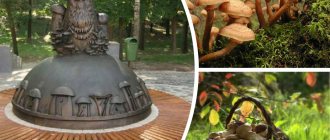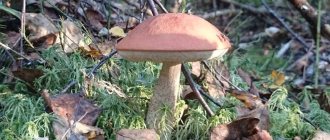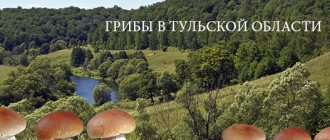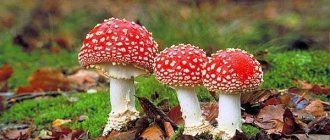Mushrooms
0
1386
Article rating
Kira Stoletova
For lovers of “quiet hunting”, the hunting season begins with the arrival of the first spring warmth. Spring honey mushrooms are not very common in the Leningrad region. Their mass collection begins in the summer.
Honey mushrooms in the Leningrad region
General characteristics of mushrooms
A good addition to the daily diet are vegetables, fruits and forest delicacies, which include different types of mushrooms. Summer and autumn honey mushrooms in the Leningrad region do not like loneliness. They grow on mossy stumps in whole families, in scatterings, from which it is easy to prepare the most delicious dishes for a large company.
Honey mushrooms belong to the Physalacriaceae family; another name for them is Amillaria. Translated from Latin, this word means “bracelet”. They were given this name because the family of mushrooms grows like a ring or bracelet that encircles a fallen trunk or the base of a stump.
More often, such mushrooms choose shaded and damp places, in thickets or in old windbreaks. From a small droplet, vaguely similar to a hat, a group of adult individuals quickly appears, the appearance of which is characterized by:
- thin plate-shaped cap;
- color changes from yellow to brown or brown;
- the leg is graceful, thin, no more than 10 cm;
- beige base;
- the plates are frequent and whitish.
The older the mushrooms, the darker their stem becomes and the less noticeable the bulge on top of the cap. Thin stripes are clearly visible on the edge. Thin plates grow along the edges, gradually darken and brown spore powder appears on their surface.
The honey fungus grows up to 18 cm in height. The overgrowths reach 23-25 cm. The structure of the stalk is usually fibrous; the older the mushroom becomes, the more fibrous it will be. The shape of the leg is cylindrical. It is literally “stuffed” with chitin, which can cause gastrointestinal problems. Therefore, there is nothing useful in the legs and when collecting honey mushrooms, they only take their caps.
Honey mushrooms are characterized by a small, cute “skirt” in the center of the leg, under which characteristic scales are visible, small but clearly visible.
The pulp is slightly watery and loose. The cut does not change color. The aroma is strong.
What mushrooms can be picked in the Leningrad region
There is a list of generally accepted edible mushrooms. Porcini mushrooms come here. The mushroom is large in size; the diameter of the cap sometimes reaches 50 centimeters.
Butternuts are distinguished by their brown cap and oily surface. During cleaning, the skin comes away from the body of the mushroom.
Boletuses begin to appear in mid-summer and grow until November. They can be found in pine forests, on the edges. Most often they are found in pine and mixed forests.
Moss mushrooms are also edible mushrooms. They can grow independently or in small clumps. They begin to appear in mid-summer and are found until the end of autumn. The mushroom prefers deciduous or completely coniferous forests.
Honey mushrooms are most often encountered by mushroom pickers with different experiences. They may be slightly concave in shape and orange in color. They grow in large groups, most often where there are a lot of stumps and fallen trees.
The first honey mushrooms appear after August 15, and continue to grow until the very end of autumn. Honey mushrooms are one of the types of mushrooms that are often found after October.
Boletus love forest roads. The mushroom cap can be brown or gray in color and up to 15 centimeters in diameter. You should pick mushrooms far from the roadway or industrial facilities.
Even if you encounter a boletus mushroom on the way home, but there is a roadway nearby, it is better not to take such mushrooms.
Varieties
In total, there are more than 40 species in the world belonging to the honey mushroom group. There are about 10 of them growing in Russia. In the Leningrad region there are several especially popular ones, including edible and false ones.
Edible
- northern;
- thick-legged;
- hemp;
- Assumption;
- meadowmen.
Their difference lies in their habitat, which determines their external color, taste, aroma and chemical properties.
Northern autumn honey mushrooms: the cap reaches 10 cm in diameter, is convex, with an olive tint, and is often brown-orange. A light spot is clearly visible in its center and the entire surface is covered with scales that are darker in comparison with the main background of the cap. The rough, uneven edge has a dark yellow color. And the leg becomes wider at the bottom and reaches a height of 10-12 cm. In some cases, its diameter can be 2 cm. In the middle of the leg, dry to the touch, a well-defined film ring with small scaly formations is visible. The flesh of the northern honey fungus is light, resembles cotton wool in consistency, and has a bright aroma and taste.
Irina Selyutina (Biologist):
Northern autumn honey mushrooms are considered the most common representatives of autumn honey mushrooms in central Russia. They are found, perhaps, everywhere, excluding only the Far North. How widespread fruiting will be depends on the weather. Autumn northern honey mushrooms bear fruit in layers and during the “quiet hunting” season there can be 2-3 of them. Almost always they are found in fairly voluminous aggregates. These honey mushrooms are capable of parasitizing 250 species of both woody and herbaceous plants and can even destroy nurseries and plantations where they grow not tree seedlings, but... irises or potatoes.
Their usual place of growth is dead wood and stumps of coniferous and deciduous trees. This species also grows in birch groves, oak or alder. Fruits from late summer to October. If the season is warm, it occurs in November.
The appearance of mushrooms depends on the habitat
Autumn thick-legged honey mushrooms: another edible species that can be grown at home. Its Latin name is Armillaria lutea. The hat is conical, wide, with compacted edges, folded downwards. Its color is brown or yellow. Some “hairiness” of the surface is typical. The leg has a noticeable slight thickening at the bottom and scales along its entire surface. It grows up to 10 cm. The pulp is dense and has a cheese aroma. This is a lamellar type of saprophyte, which is found on a cushion of rotten leaves, on fallen needles or bark. Families feel good on burnt surfaces and trunks of deciduous trees that have fallen after lightning.
Assumption honey mushrooms: the species got its name from the holiday of the same name - the Dormition of the Blessed Virgin Mary. The collection begins on the holidays and lasts until the end of November, until the onset of frost. The stem is yellow or brown, thin, no more than 10 cm high. The color of the cap matches the color of the stem. On the surface, in the center of the cap, a bulge is noticeable; below it has frequently located plates. A thin “skirt” is visible on the leg, which becomes thinner over time and breaks.
In addition to edible ones, false heels, conditionally edible ones, or their poisonous counterparts grow in the Leningrad region. External description of conditionally edible mushrooms:
- spores have a characteristic blue color;
- the main color of the cap is bright, yellow or orange;
- surface with a yellow tint;
- there are no scales.
When harvesting honey mushrooms for future use, you should not forget that the legs of adult representatives are hard, so it is better to collect young specimens. In addition, it is also important that with insufficient heat treatment, honey mushrooms are mildly poisonous and can cause the development of gasteroenteritis (inflammation of the digestive tract). Therefore, cold and dry salting is completely excluded for them. They are salted only hotly after preliminary boiling. This mild toxicity is believed to occur after the first frost.
They cannot cause serious poisoning. But if cooked incorrectly, not soaked enough or not cooked before the main cooking, symptoms of poisoning may occur: nausea, vomiting and diarrhea.
Specific habitats of forest gifts
So, mushroom places in the Leningrad region - where are they?
- Near the village of Sinyavino (59.54 N, 31.04 E). The settlement is located 45 km southeast of St. Petersburg. You can get to it either by car or by train. The latter runs 3 times a day from Ladozhsky station. In the forests around the village boletus, chanterelles and saffron milk caps grow, and sometimes you can find porcini mushrooms and capsicum mushrooms.
- In the forests around Vyritsa (59.24 N, 30.20 E). This is again a southern direction: the town is located 60 km south of St. Petersburg. At the end of July, chanterelles, milk mushrooms and russula grow in the local forests. To avoid getting lost, you should walk along the Oredezh River. In addition to picking mushrooms, the traveler has every chance to get vivid impressions of summer nature.
- In Sosnovo (60.33 N, 30.14 E). Mushroom places in the Leningrad region are unthinkable without this wonderful place. The forests around the village are famous for a variety of mushrooms. What gifts of the forest can you find in the coniferous and spruce forests that surround this settlement! These include boletus mushrooms, boletus mushrooms, moss mushrooms, and boletus mushrooms in the area of sunny clearings! Closer to autumn, it is quite possible to pick a basket of milk mushrooms or chanterelles for pickling. You can spend a whole day picking mushrooms in Sosnovo. It will be remembered, like everything beautiful that is associated with summer and wonderful nature.
- Near the village of Stekolnoye, which is located in the Tosnensky district (59.33 N, 30.54 E). Local forests invariably delight mushroom pickers with a rich harvest of young boletus mushrooms. But no one promises that the search for these noble representatives of flora (or fauna?) will be simple. You will have to get lost, search, strain your logic... Only a patient and resourceful mushroom picker will be generously rewarded.
In this section we have listed the coordinates of mushroom places in the Leningrad region. We hope they will help everyone find their favorite gifts of the forest.
Places where honey mushrooms grow in the region
Cleared clearings of mixed forests and larch are a suitable place to search for autumn mushrooms. This is where they go for these mushrooms.
In Priozersk and the Vyborg districts, the mass harvest occurs at the beginning of September. At this time of year, the still warm, but already humid weather contributes to the rapid growth of new families.
There are many pine trees near the village of Sosnovo, which is located in the center of the forest. Whole clusters of autumn honey mushrooms settle on their root collars.
In addition to these varieties, other mushrooms grow in this area: oyster mushroom, russula, milk mushroom, chanterelle and trevally. And after the warm rain, the lucky ones manage to find boletus and boletus.
Mushroom places of the Leningrad region
Preparing to go into the forest
The mushroom season is already in full swing, which means it's time to get out into nature. The editors of ivbg.ru have selected a list of must-see places depending on what mushrooms you prefer.
Photo: Travelask.ru
Mushroom picker's memo: 1. The first rule of a mushroom picker: if in doubt, don't take it. And, especially, don’t try! 2. You need to go for mushrooms in the morning: while the dew is glistening on the caps, the mushrooms will be easier to find. 3. Shoes and clothing should be comfortable and as closed as possible, this way you will protect yourself from sharp twigs and insects. 4. Don’t forget to take with you a container of water, a knife and a map (or better yet, a navigator). 5. Get a “magic wand” that will be convenient for lifting moss, leaves and sticks (if you don’t want to bend down every time), it is advisable to have a “slingshot” at the end of the stick. 6. To collect mushrooms, it will be more convenient to get a basket or basket. This way the mushrooms will last longer. 7. Do not use bags, bags or backpacks to collect mushrooms. The exception, perhaps, is chanterelles. They do not break or crumble during transportation. 8. It is advisable to fold tubular mushrooms with the cap facing up, small ones - whole, cut off the stem of large ones. 9. You cannot take overripe old mushrooms. Toxic and harmful substances can accumulate in them. 10. Almost all mushrooms, as a rule, grow in families. If you find one, look for another one nearby. 11. Mushrooms cannot be stored for a long time (no more than 2-3 hours). Therefore, upon returning from the forest, you should immediately sort them out and begin processing. The rapid spoilage of mushrooms is associated with a high moisture content and, accordingly, in rainy weather the mushrooms will spoil faster.
Photo: aif.ru
12. You can store unprocessed mushrooms in the refrigerator for several hours. If you don’t have a refrigerator, you can stack the mushrooms in one layer and place them in a cool place. 13. If it is not possible to sort the mushrooms right away, you should pour salted boiling water over them: then they will not spoil within 24 hours. 14. All mushrooms, in particular lamellar and russula, must be cut only with the stem to ensure that there is no filmy ring characteristic of the toadstool. 15. Always carefully check your “catch”; remember: even a small part of the pale grebe is enough to send a person on his last journey. 16. For drying, salting and pickling, you need to take whole and strong mushrooms. 17. Never. Not. Try it. Mushrooms. On the. Taste. Even if they smell nice. 18. Conditionally edible mushrooms (they are used for pickling) should be immediately placed in a saucepan and filled with cold water in order to remove the bitterness and milky juice. 19. You cannot use galvanized and aluminum utensils for salting and marinating. 20. It is not advisable to go mushroom hunting alone; in a large group there is less risk of getting lost. If you are walking alone, then warn your relatives and friends, indicating the approximate route and how far you will go.
Beneficial features
Honey mushrooms have beneficial properties that are determined by their chemical composition. They are rich in phosphorus, potassium, fiber, vitamins and amino acids. Because they are rich in fiber, they are called “forest meat.” They are consumed during fasting, replacing poultry or animal meat.
In case of anemia, they help the process of hematopoiesis. To replenish the daily requirement of zinc and copper, you need to eat only 100 g of autumn mushrooms daily.
To replenish the level of calcium and potassium, they are indispensable in the diet of vegans (supporters of the strictest vegetarian diet, which completely excludes any products of animal origin, although in rare cases they can use honey in food) and vegetarians, because. These substances do not enter their body due to a lack of animal products.
In what cases is it better to simply admire the bounty of the forest?
When there is even the slightest suspicion that a mushroom is edible.
The most poisonous mushrooms in the Leningrad region are toadstool, satanic mushroom and red fly agaric. And also all the unfamiliar and dubious gifts of the forest. This is the rule of a wise mushroom picker. Even the most experienced specialist will not take an unknown mushroom into his basket.
Finally, I would like to reassure the reader: only poisoning with the well-known pale toadstool leads to death. In all other cases, people survive (the consequences depend on how strong the liver and kidneys are). Another thing is that such experiments are obviously pointless. Next we will tell you about edible and healthy mushrooms of the Leningrad region, photo is attached.
boletus
Although boletus does not have a special taste, it is easy to find and can save a mushroom picker if no other mushrooms are found in the forest. The color of the plant varies, from standard brown to light cream. Light colored mushrooms love to grow in swampy areas. It is recommended not to cut old boletus mushrooms whose head is more than 5 cm. They will break in the basket, and the stem of such a mushroom will be very hard.
The boletus has a similar grebe. If the bottom of the cap is pink, then you need to throw away the mushroom - it's a toadstool. Additionally, the false plant will have a bitter taste. The photo shows what an edible boletus looks like:
boletus
Mushroom season is in full swing: where is the best place to collect forest products near St. Petersburg
St. Petersburg residents reported that mushrooms had appeared in the outskirts of the city. In the Kurortny district, lovers of “silent hunting” collected one and a half hundred boletus mushrooms at once. However, not everyone is lucky - in the Slantsevsky district of the Leningrad region, residents complained about the lack of forest gifts. NEVSKIE NEWS found out what it takes to collect full baskets.
